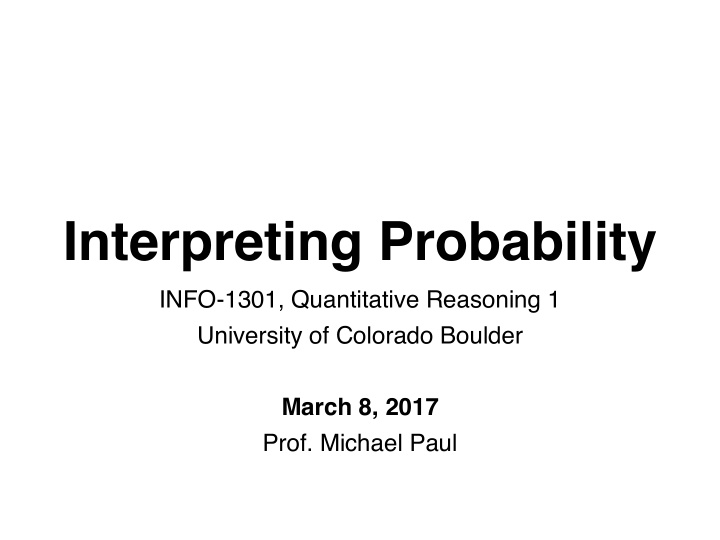



Interpreting Probability INFO-1301, Quantitative Reasoning 1 University of Colorado Boulder March 8, 2017 Prof. Michael Paul
Probability as Advertising • The Joseph Schlitz Brewing Company, created in 1849, was once the largest beer manufacturer in the US. • Started having hard times in this competitive industry in the 1960s
Probability as Advertising • Disastrous 1977 TV ad campaign • Viewers found the ads menacing, and were spoken of as the “Drink Schlitz or I’ll kill you” ad campaign.
Probability as Advertising
Probability as Advertising • Schlitz believed that all of these inexpensive beers tasted alike, and that in a blind test, the probability of selecting Schlitz over Michelob was similar to flipping a coin • Probability of getting at least 40% of blind tasters to choose Schlitz is: • .83 if n=10 • .98 if n=100 • .9999999999 if n=1000 • Indeed, on live TV, exactly 50 of the 100 avowed Michelob drinkers chose Schlitz.
Probability as Risk Assessment • After the 9/11 terrorist bombings, fewer people used air travel • Many people began to drive rather than fly • But the probability of a fatal crash, per mile, is much higher in a private automobile than on a commercial airplane. • Three Cornell statisticians did calculations that indicated that there was an increase of 344 additional traffic deaths in each of the first three months after the bombings than there would have been. • People eventually returned to flying, so the extra traffic deaths tailed off; but the statistical model indicates a total of approximately 2,000 additional deaths because of people’s fear to fly.
Probability as Risk Assessment • Bill Gates has worked to raise awareness of the dangers of mosquitos and the diseases they carry (e.g., Malaria) “What ¡would ¡you ¡say ¡is ¡the ¡most ¡dangerous ¡animal ¡on ¡ Earth? ¡Sharks? ¡Snakes? ¡Humans? “Of ¡course ¡the ¡answer ¡depends ¡on ¡how ¡you ¡define ¡ dangerous. ¡Personally ¡I’ve ¡had ¡a ¡thing ¡about ¡sharks ¡ since ¡the ¡first ¡time ¡I ¡saw ¡Jaws. ¡But ¡if ¡you’re ¡judging ¡by ¡ how ¡many ¡people ¡are ¡killed ¡by ¡an ¡animal ¡every ¡year, ¡ then ¡the ¡answer ¡isn’t ¡any ¡of ¡the ¡above. ¡It’s ¡mosquitoes.”
Probability as Risk Assessment • Human psychology makes it difficult for most people to correctly interpret and evaluate probabilities • Implications for how you communicate uncertainty! • In a series of experiments, participants were told that weather forecasts called for a 30% chance of rain in both Seattle and Phoenix. When participants were later asked how likely they were to bring an umbrella on a trip to either city, they revealed that they believed it was more likely to rain in Seattle. • People thought a 30% chance of rain in Seattle was more likely to result in rain than a 30% chance of rain in Phoenix. https://www.psychologytoday.com/blog/the-‑inertia-‑trap/201303/why-‑are-‑people-‑bad-‑ evaluating-‑risks
Probability as Risk Assessment • Another psychology experiment: choose a program to help 600 people with a life-threatening disease • Group 1: • Program A: “200 people will be saved” • Program B: “there is a one-third probability that 600 people will be saved, and a two-thirds probability that no people will be saved” • Group 2: • Program C: “400 people will die” • Program D: ”there is a one-third probability that nobody will die, and a two-third probability that 600 people will die” • In group 1, 72% of participants preferred program A. In group 2, 22% preferred program C.
Independence Assumptions • Sometimes independence of events is inappropriately assumed • Sudden Infant Death Syndrome (SIDS) has a 1 in 8500 chance of occurring in Britain • A famous pediatrician (Sir Roy Meadow) claimed that if there are two SIDS deaths in the same family, there is a criminal problem because the probability would be 1/8500 x 1/8500 = 1/73 million • The government used this observation to convict a number of dual death parents of murder
Independence Assumptions • This calculation assumes that the two SIDS deaths are independent. • Is this a good assumption? • A genetic predisposition might make a second death quite likely if there is a first death. • After arguments by the Royal Statistical Society, the government reviewed 258 trials in which parents were convicted of murdering their infant children and overturned many of them.
Independence Assumptions • Sometimes dependence of events is inappropriately assumed • Example: “streaks” or “hot hands” in sports • Widespread belief that if an athlete makes one shot, the next shot is more likely also to be made • Three statisticians looked at shooting from the field data for the Philly 76ers for the 1980-81 season, as well as free throw data for the Boston Celtics. • Found no positive correlation between the outcome of successive shots
Monty Hall Problem • At end of the TV show, Let’s Make a Deal • Contestant has to choose between 3 doors • Desirable prize behind one door, a goat behind the other two • Contestant has 1 in 3 chance of winning the big prize
Monty Hall Problem • Twist to the game: once the contestant had chosen a door, Hall opened one of the other two doors – always choosing one with a goat behind it • Hall then asked if the contestant wants to switch from the initial choice to the other closed door • Should the contestant switch? Yes! The probability is higher. Why??
Monty Hall Problem Before: After:
Computational Simulations • Important to understand that computers can’t actually do randomness • Instead, algorithms generate “pseudorandom” numbers • Sequence of numbers that have the properties of randomness (not predictable) • The first number in the sequence is called a “seed” or “base” • If you generate pseudorandom numbers starting with the same seed, you’ll get the same numbers • Allows you to reproduce an experiment with probabilistic results
Recommend
More recommend